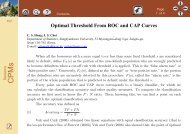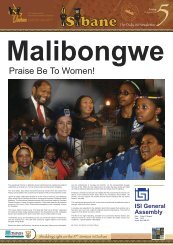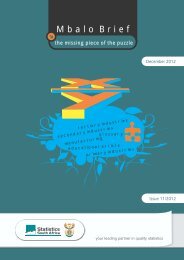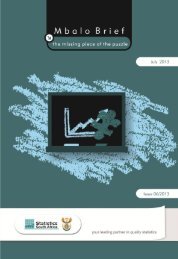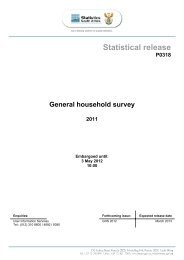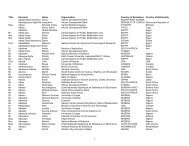Post-enumeration Survey (PES) - Statistics South Africa
Post-enumeration Survey (PES) - Statistics South Africa
Post-enumeration Survey (PES) - Statistics South Africa
Create successful ePaper yourself
Turn your PDF publications into a flip-book with our unique Google optimized e-Paper software.
<strong>Statistics</strong> <strong>South</strong> <strong>Africa</strong><br />
5<br />
• There is independence between census and <strong>PES</strong>, i.e. the organisation of the census and <strong>PES</strong>,<br />
especially fieldwork operations, must be managed by different teams.<br />
• There is absence of erroneous inclusions in either the census or <strong>PES</strong>.<br />
• There are no incomplete matches. Any failure to match census and <strong>PES</strong> items should be due to<br />
actual omission and not the inability to match.<br />
There are three alternative procedures for evaluating census coverage in a <strong>PES</strong>. These three<br />
procedures are known as A, B, and C (see Annexure A for definition of terms).<br />
Procedure A<br />
• Seeks to reconstruct the households as they existed at the time of the census.<br />
• The respondent must identify all persons in the sample household on the census reference date.<br />
• The aim is to match these persons (non-movers and out-movers) to the census questionnaires, and<br />
to estimate the number and percentage of matched non-movers and movers (out-movers).<br />
• The matching of non-movers and out-movers is relatively simple and inexpensive because the<br />
search is limited to sample areas, but it is difficult and expensive to locate out-movers, especially<br />
out-mover households, given that they are no longer at the sample address (information, when<br />
available, is reported by proxy respondents), hence, there is a strong possibility of underestimation<br />
of the number of movers (out-movers).<br />
• This leads to underestimation of the census omissions.<br />
Procedure B<br />
• Seeks to identify all persons in the sample household on the reference date of the <strong>PES</strong>.<br />
• People respond for themselves; hence field <strong>enumeration</strong> is more complete than in Procedure A.<br />
• The aim is to match these persons (non-movers and in-movers) to the corresponding census<br />
records and to estimate the number and percentage of matched non-movers and movers (inmovers).<br />
• It provides a better estimate of the number of movers than Procedure A, but associated difficulties<br />
and costs of matching are far greater because it involves searching for in-movers in the area where<br />
they were enumerated during the census.<br />
• It is not sure if failure to match means an actually omitted person or an incorrectly located person.<br />
• This leads to overestimation of the census omissions.<br />
<strong>Post</strong> Enumeration <strong>Survey</strong> (<strong>PES</strong>)



